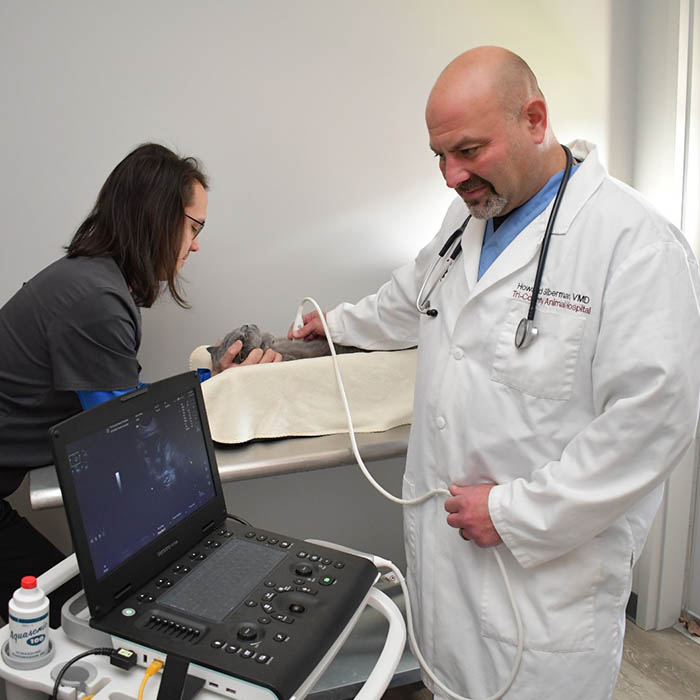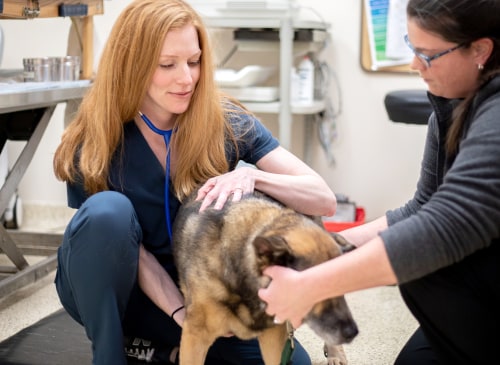Common Symptoms That Your Pet Might Need a Cancer Veterinary Near Me}
Wiki Article
What You Need to Know Regarding Vet Services: An Introduction of Diagnostic Tools and Procedures
Veterinary solutions play a vital role in maintaining the wellness of pet dogs. Routine check-ups can expose surprise wellness worries at an early stage. Various diagnostic devices and procedures, such as blood examinations and imaging methods, offer crucial understandings into an animal's well-being. Comprehending these methods is essential for pet owners. What particular diagnostic treatments are most commonly made use of, and exactly how can they impact a family pet's therapy strategy?Importance of Routine Vet Examinations
While many family pet proprietors may underestimate the value of routine veterinary exams, these visits are vital for maintaining a pet's overall health. Regular check outs to the vet enable very early discovery of potential health and wellness issues prior to they escalate right into major issues. Regular exams typically consist of vaccinations, which are necessary for preventing transmittable illness that could seriously impact a pet's well-being. In addition, these appointments give a chance for veterinarians to examine the animal's weight, oral wellness, and general problem, making certain that the pet is thriving. Throughout these brows through, animal proprietors can also get useful advice on diet plan, workout, and preventive treatment customized to their details animal's needs.Common Analysis Procedures in Veterinary Medication
In veterinary medication, accurate diagnosis is crucial for reliable therapy. Common analysis treatments include blood screening methods, advanced imaging innovations, and urinalysis, each playing a considerable duty in recognizing health and wellness problems. Recognizing these approaches improves the capacity to offer appropriate treatment for pet clients.Blood Checking Strategies
Blood testing methods function as essential analysis tools in veterinary medicine, making it possible for vets to assess the health of animals properly. These methods include gathering blood examples to assess various elements, such as red and white blood cells, platelets, and biochemical markers. Usual tests consist of complete blood matters (CBC), which examine total wellness and spot infections, and biochemical panels, which evaluate body organ feature and metabolic standing. Furthermore, serological tests can determine details illness through antibody discovery. Blood screening is minimally invasive and provides critical info that aids in detecting problems, keeping an eye on health and wellness condition, and reviewing feedbacks to treatments. In general, these methods play an essential function in guaranteeing perfect take care of pets and animals alike.Imaging Technologies Used
Diagnostic imaging innovations are important devices in vet medicine, enhancing blood testing methods by giving aesthetic understandings into a pet's inner frameworks. Usual imaging modalities include X-rays, which work for examining bone cracks and identifying foreign things, and ultrasound, which permits for real-time visualization of soft cells and body organs. Magnetic vibration imaging (MRI) offers comprehensive photos of complex physiological areas, particularly in neurological evaluations. Computed tomography (CT) offers cross-sectional pictures, improving diagnostic accuracy for various conditions. Each of these innovations aids veterinarians in diagnosing illnesses, planning treatments, and keeping an eye on healing. By integrating imaging modern technologies, veterinary specialists can much better examine an animal's health and wellness and make educated choices concerning their care.
Urinalysis and Diagnostics
Urinalysis acts as a crucial diagnostic tool in vet medication, offering useful insights into a pet's general wellness and helping in the discovery of numerous problems. This non-invasive treatment examines urine samples to analyze kidney function, hydration status, and metabolic problems. Typical components taken a look at consist of particular gravity, pH degrees, glucose, healthy proteins, and the existence of blood or bacteria. Irregular findings can show issues such as urinary system infections, diabetes mellitus, or kidney illness. To enhance diagnostic precision, urinalysis is commonly carried out combined with various other tests, such as blood job and imaging studies. Early discovery through urinalysis can cause timely treatments, improving the diagnosis for several vet patients. It is a crucial element of detailed veterinary treatment.Recognizing Blood Tests and Lab Evaluation
Understanding blood tests and research laboratory analysis is important in vet medicine as it aids in identifying numerous wellness conditions in animals. Various kinds of blood examinations offer crucial information about an animal's inner state, while translating laboratory results calls for careful consideration of countless factors. This section will explore the kinds of blood examinations readily available and the significance of their results.Sorts Of Blood Tests
Blood tests play an essential function in veterinary medication, supplying crucial understandings right into a pet's health status. Various kinds of blood tests are made use of, each serving various objectives. Complete blood counts (CBC) analyze total wellness and spot problems such as anemia or infection. Biochemical accounts examine body organ function by determining electrolytes and enzymes, supplying understandings right into metabolic wellness. Serological tests recognize details antibodies or virus, assisting in the medical diagnosis of infections or autoimmune conditions. Blood keying assurances risk-free transfusions, while coagulation tests evaluate the blood's capability to clot, vital for surgeries. These examinations jointly improve diagnosis, therapy preparation, and surveillance of an animal's health, illustrating the importance of complete lab analysis in vet care.
Analyzing Laboratory Results
A complete analysis of lab results is essential for precise medical diagnosis and therapy in veterinary medication. Interpreting lab results requires an understanding of typical referral varieties and the relevance of inconsistencies. Blood examinations can disclose different wellness indications, such as body organ feature, electrolyte equilibrium, and the presence of infections. Veterinarians need to take into consideration the whole scientific image, consisting of the pet's background, physical exam findings, and any type of signs and symptoms offered. Variants click here to find out more in results might emerge from factors such as age, breed, and underlying wellness problems. Lab outcomes need to not be viewed in isolation but instead as component of an all-inclusive analysis approach. Precise interpretation enables tailored therapy plans and better end results for vet people.Imaging Techniques: X-rays, Ultrasounds, and Beyond
Imaging methods are necessary tools in veterinary medication, giving essential understandings into the health and health of animals. Amongst one of the most frequently used approaches are X-rays and ultrasounds. X-rays are indispensable for visualizing bone frameworks, assisting veterinarians identify cracks, tumors, or international objects. This approach is fast and non-invasive, making it ideal for immediate situations.Ultrasounds, on the other hand, make use of acoustic waves to create pictures of soft cells and body organs. This technique is particularly beneficial for examining the heart, abdominal area, and reproductive organs, permitting veterinarians to analyze conditions like liquid buildup or body organ abnormalities.Beyond X-rays and ultrasounds, advanced imaging methods such as computed tomography (CT) and magnetic vibration imaging (MRI) are increasingly made use of in veterinary technique. These methods use thorough cross-sectional images, improving the precision of diagnoses and treatment strategies. Ultrasound For Dogs. In general, imaging strategies play an important function in ensuring efficient vet treatmentThe Role of Biopsies in Diagnosing Animal Wellness Issues
Precision in identifying wellness concerns in pets commonly hinges on making use of biopsies, which offer clear-cut info about tissue irregularities. A biopsy includes the elimination of a tiny sample of tissue for evaluation under a microscope, enabling vets to identify various conditions, including infections, growths, and inflammatory conditions. This analysis device is essential for comparing benign and deadly developments, leading therapy decisions, and assessing the intensity of a condition.Biopsies can be done making use of different strategies, such as needle desire, incisional biopsies, or excisional biopsies, relying on the area and sort of cells entailed. The choice of approach might impact healing time and the quantity of tissue collected. Inevitably, the details obtained from a biopsy can bring about targeted therapies, boosting outcomes for pets facing serious wellness obstacles. Vets stress the relevance of this treatment in accomplishing accurate medical diagnoses and effective therapy plans.Advanced Diagnostic Tools: Endoscopy and CT Checks

Advanced diagnostic devices, such as endoscopy and CT scans, play a necessary role in modern-day veterinary medication, using non-invasive methods to picture internal structures and identify numerous conditions in family pets. Endoscopy involves the usage of a versatile tube outfitted with a video camera, allowing veterinarians to analyze the stomach tract and respiratory system straight. This technique can disclose abnormalities such as growths, international bodies, or inflammation, enabling targeted therapy plans.CT scans, on the other hand, use innovative imaging technology to produce detailed cross-sectional pictures of the body (CT Scans For Animals). This method is particularly beneficial for assessing complicated frameworks like the brain, spine, and joints. By offering high-resolution pictures, CT scans help vets in determining concerns that may not appear with traditional radiography. Together, these sophisticated tools enhance diagnostic accuracy, improve therapy end results, and inevitably add to better total animal health and wellness monitoring

Translating Test Outcomes: What Pet Dog Owners Need To Know
Understanding examination results can be a challenging task for animal proprietors, especially after innovative treatments like endoscopy and CT scans have actually been executed. Analyzing these outcomes requires a grasp of clinical terminology and a clear understanding of what the searchings for show regarding the pet's health and wellness. Veterinarians usually supply explanations, however the intricacy of the outcomes can still lead to confusion.Pet owners need to proactively involve in discussions with their veterinarians, asking inquiries to clarify any type of unpredictabilities. It is vital to recognize normal versus unusual outcomes and the implications for the family pet's therapy strategy. Furthermore, identifying that some results may need additional testing or surveillance can assist owners remain notified about their pet dog's health journey. Ultimately, a collaborative technique in between pet dog proprietors and vet professionals fosters far better wellness end results and boosts the total treatment experience for family pets.Regularly Asked Inquiries
Just how Do I Pick the Right Vet Clinic for My Pet dog?
Choosing the right veterinary center entails investigating regional choices, reviewing certifications, seeing centers, and assessing team communications (CT Scans For Animals). Focusing on referrals from relied on resources can assist ensure the very best care and atmosphere for a family pet's wellness needsWhat Should I Do if My Animal Refuses to Go to the Vet?
When a pet rejects to head to the i was reading this vet, it's recommended to continue to be tranquil, use deals with or toys to attract them, and consider setting up a home go to if anxiety continues. Persistence and positive support are vital.Exist Telehealth Options for Veterinary Providers?
Telehealth choices for go to my site vet services are progressively offered, enabling animal owners to seek advice from veterinarians remotely. These services make it possible for conversations concerning health concerns, advice on small conditions, and follow-ups without requiring to check out a center.
How Often Should My Family Pet Have Dental Exams?
The regularity of dental exams for pets generally depends on their age and breed. Usually, veterinarians recommend annual oral analyses, although some family pets might call for more constant check outs to maintain perfect dental wellness.
What Are the Expenses Related To Vet Diagnostics?
The prices related to veterinary diagnostics can vary widely, generally ranging from basic examinations like blood job to advanced imaging methods. Aspects affecting expenses consist of the facility's area, tools made use of, and specific tests needed for each and every pet dog. Vet solutions play an important function in preserving the health and wellness of family pets. While several animal owners may underestimate the significance of routine veterinary check-ups, these appointments are important for preserving a pet's overall health and wellness. Furthermore, these consultations supply an opportunity for veterinarians to evaluate the animal's weight, oral wellness, and total condition, guaranteeing that the animal is flourishing. Precision in diagnosing health and wellness problems in family pets commonly pivots on the use of biopsies, which provide conclusive info about cells problems. Furthermore, recognizing that some results might need additional screening or surveillance can help proprietors stay informed concerning their pet dog's wellness trip.Report this wiki page